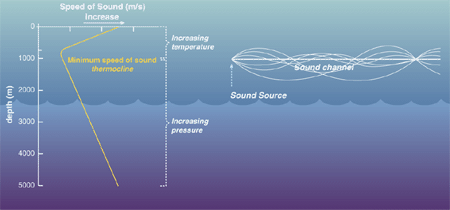
sound in water and more particularly the ocean
Somewhere along the way it was asserted that water is an excellent medium for the propagation of sound waves. In fact sound travels almost five times faster in water than in air. The travel of sound underwater is influenced by a number of factors. Just as sunlight is reflected, absorbed and scattered by our atmosphere, sound waves are reflected, scattered and absorbed by seawater. Seawater can absorb 30 times the amount of sound absorbed by distilled water. Furthermore, low frequency sounds that have rather large wavelengths which pass over small particles can travel the furthest without loss from absorption or scattering. The speed of sound underwater is also affected by the salinity, the pressure, and the temperature.
The ocean is divided into horizontal layers. The speed of sound in the upper layers depends more upon temperature, while in the lower layers pressure plays a greater role. At the surface is a sun-warmed layer. The mid-layers are well mixed by the waves, winds and currents; therefore, they tend to be isothermal (at a constant temperature). The speed of sound tends to be constant within this region. Below this layer is a transitional layer called the thermocline; the temperature drops steadily with depth within this layer. As temperature falls, the speed of sound slows. After roughly 600 meters the ocean once again becomes isothermal all the way to the floor. In this region pressure is the factor dominating the speed of sound. Increasing the pressure increases the speed of sound. Due to the laws of refraction, sound waves can be trapped in a narrow channel at the bottom of the thermocline and the top of the lower isothermal layer. The channel acts a s a wave guide carrying sounds thousands of miles. This deep sound channel is also known as the sound fixing and ranging (SOFAR) channel. A sound wave traveling through the thermocline will bend downward as the speed decreases. When it reaches the isothermal layer the increasing pressure cause an increase in speed and the wave bends up. The process repeats itself ad thus the wave travels on and on with a minimum loss of signal.

Sounding Out the Oceans Secrets, NationalAcademy of Sciences,1999. http://www4.nas.edu/beyond/beyonddiscovery.nsf/web/ocean6?OpenDocument